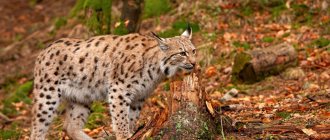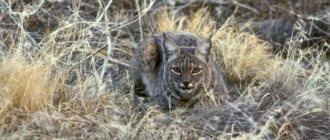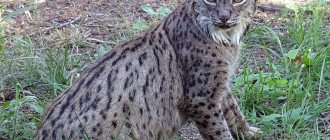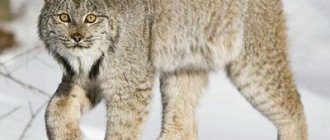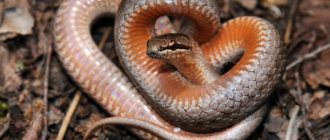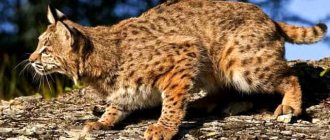The lynx is a member of the cat family, a solitary, secretive animal that inhabits the dense forests of Europe, Asia and North America. The animal is easily recognized by its black tufts on its ears and short tail.
Its keen eyesight gives this cat legendary status in the myths of many cultures. In Greek, Scandinavian and North American myths, the lynx sees what others do not, its role being to reveal hidden truths. As for the name of the animal, it most likely comes from the Greek word “leukos”, meaning “bright”. It turns out that the beast was named so because its eyes glowed in the dark.
Description
Of the four species of lynx, Eurasian lynxes are the largest. They are also considered one of the largest predators in Europe, after brown bears and gray wolves. Body weight ranges from 18 to 36 kg, and length - from 70 to 130 cm. Height at the withers ranges from 60 to 65 cm. Sexual dimorphism is present, males are larger and stronger.
The coat is grey, red or yellow. There are three types of patterns: spotted, striped and solid. Large spots, small spots and rosettes may be present on the animal's body. Drawings depend on the habitat. The belly, front of the neck, inside of the paws, and ears are white. The tail is short, with a hard black tip. Eurasian lynxes have long paws, sharp and retractable claws, a round muzzle, and triangular ears. Characteristic features of a common lynx: black tufts at the ends of the ears and noticeably elongated “whiskers”. The paws are large and covered with hair, which helps them move through deep snow.
Appearance Features
The lynx is a medium-sized animal with a relatively short body, raised high on its legs and a wide, short head. Unlike other wild cats, the animal’s tail is short, like a “cut” - from 9 to 12 centimeters in length, its tip is black.
Lynxes are very mysterious animals and have earned themselves the nickname “shadow of the forest.”
The legs are quite thick, and at the same time slender, with large rounded paws with sharp retractable claws. Most animals live in areas where everything is buried in deep snowdrifts in winter, and their elongated limbs help them maneuver in this snowy environment. In addition, in winter the paws are well furred: the hair on the underside of the limbs provides traction on slippery surfaces. The exception is the red lynx, which does not have furry soles like its relatives, but it does not live in areas of heavy snowfall. In general, no other feline animal is as well adapted to snow and cold as our heroine.
The winter fur of the lynx is up to 10 cm long, soft and thick, and has different colors: golden, ash-blue, smoky, gray-brown, red. Moreover, there is such a pattern: the colder the climate in which the animal lives, the lighter the fur. Almost always it is dotted with dark spots, large on the back and sides, small on the legs. On the belly and chest, the fur is even longer and softer, almost always pure white with rare speckles. Around the neck the coat is more luxuriant and forms a collar.
Summer fur is more brightly colored, coarser and shorter than winter fur.
The lynx's calling card is its ears - small, erect, triangular in shape, crowned with long black tassels. All types have brushes, but their purpose is not entirely clear. Some scientists believe that they enhance the animal’s hearing, others that they are needed for communication between animals.
The animal's face is decorated with whiskers - elongated sections of fur on both sides of the chin. The lynx's eyes are round, elliptical in shape, the outer corners of the eyes form an acute angle, the color of the iris is usually sandy.
Area
The Eurasian lynx is one of the most widely distributed cat species. Their habitat includes Russia, Central Asia and Europe. Today they occupy an area from Western Europe through the boreal forests of Russia to the Tibetan Plateau and Central Asia. The habitat is greatly limited by the presence of people and their activities. The common lynx is difficult to find in areas with a large number of settlements, railways and roads, as these factors cause an increase in mortality and injury. The habitats of lynxes depend on the availability of forest cover. Deforestation is preventing the common lynx from dispersing throughout Europe and Asia.
Table of ranks
This creature with tufts on its ears, like many other animals, has its closest relatives - its own subspecies. The classification of the common lynx includes several subspecies:
- Altai;
- Amur;
- Baikal;
- European;
- Caucasian;
- Carpathian;
- Turkestan;
- Yakut
It is worth noting that the lifestyle and description of each of these subspecies are practically no different from each other. By the way, the lynx genus is listed in the International Red Book as an endangered species, but more on that later.
Reproduction
Reproduction takes place every year, from February to April. The female's estrus lasts about three days per season. The male and receptive female spend several days together and copulate many times a day. After the female ends her heat, the male leaves her and looks for another. The female has only one partner per season.
Gestation lasts from 67 to 74 days, with cubs born in May. The interval between matings depends on the success of the previous season. Females without young will mate every year, and females with young will mate approximately every 3 years. As a rule, a female gives birth to 2 to 3 lynx cubs. Newborns weigh from 300 to 350 g and depend on the nutrition and protection of the mother. They are weaned at 4 months and become independent at 10 months. Sexual maturity in females occurs at 2 years of age and continues until 14 years of age, while males mature after 3 years of age and are able to reproduce until 17 years of age.
Family ties and babies
With the onset of the last month of winter, the mating season for lynxes begins, and it lasts until the end of March. Males fight selflessly to take possession of the female. Their growls and loud meows can be heard throughout the area. The female goes with the winner.
She carries the cubs for two months. On the eve of childbirth, parents set up a den, a kind of delivery room. It is located either in a hollow tree 15 meters above the ground, or in rock crevices.
Usually two or three lynx cubs are born. In rare cases, up to five babies are born. Newborns are very small (up to 300 g). Two weeks after birth, kittens open their eyes.
Raising the offspring lies entirely with the mother; the father does not take part in this process. At three months, lynx cubs begin to follow their mother, and at five months they begin to receive lessons in independent hunting. One-year-old individuals enter adulthood.
Nutrition
Like other members of the cat family, bobcats are strictly carnivorous and consume only meat. Other species (Canada lynx, Iberian lynx and bobcat) of lynx prefer rabbits and hares. The Eurasian lynx hunts mainly ungulates. Small ungulates such as the European roe deer (Capreolus Capreolus), musk deer and chamois (Rupicapra rupicapra) make up the majority of their diet, but European lynxes are known to prey on large ungulates such as moose and caribou due to their vulnerability during the winter. Common lynxes also supplement their diet with foxes, rabbits, hares, rodents and birds. They consume 1 to 2 kg of meat per day. The Eurasian lynx stalks its prey by camouflaging itself in dense vegetation and approaching quietly to avoid being noticed. It then pounces on the prey and delivers a fatal bite to the neck or face until the animal suffocates. They hide the killed victim under logs or cover it with vegetation so that they can later eat it in private. They hide uneaten prey in hiding places and later return for it.
In most of their habitat, Eurasian lynxes overlap with three other large predators: gray wolves, brown bears and wolverines. Brown bears are mostly omnivores and do not compete much with lynxes for prey. Gray wolves and lynxes generally exist peacefully. They have different preferences and hunting styles. Gray wolves are larger than common lynxes and primarily hunt deer, while Eurasian lynxes focus on roe deer and small ungulates. Lynxes are solitary hunters who hide in dense vegetation, behind fallen logs, or in the snow before attacking. Competition between these species may occur in areas where roe deer, deer, or other ungulates are scarce.
Natural enemies of the lynx
The life of these cats in the wild certainly cannot be called peaceful and serene. After all, furry beauties have to share territory with many formidable predators, who not only deprive them of their legitimate prey, but also, if possible, try to deal with such a strong competitor.
It is better for lynxes not to meet with a wolf pack
Among the representatives of the animal kingdom, the main enemies of the lynx are wolves. Moreover, for inexplicable reasons, they simply hate each other, and their confrontation has been going on since time immemorial. What’s interesting is that gray animals are well aware that they definitely cannot survive in a single fight against a lynx. But if a cat’s path is blocked by a whole pack of wolves, then its only chance of salvation is to take refuge in the nearest tree, otherwise the hungry pack will tear its sworn enemy to shreds.
Their closest relatives from the cat tribe also pose a considerable danger to lynxes. Snow leopards and Amur tigers live next to the Eurasian lynx, and the Canadian variety has such a large and ruthless predator as the puma as neighbors. None of them conduct a targeted hunt for the spotted cat, but they often leave the lynx hungry, taking away its hunting trophy.
The enmity between lynxes and wolverines has lasted for many centuries.
Among the natural enemies of lynxes are wolverines. These evil animals often follow spotted predators, and as soon as the cat gets food for itself, they immediately try to take away someone else's prey. And although wolverines are inferior in size to lynxes, they are equal in strength, moreover, the fight between them often ends in the death of the furry beauties.
But over their centuries-old history, lynxes have adapted to survive alongside large predators, and they have many ways in their arsenal to avoid the sharp teeth and claws of their formidable four-legged neighbors. But spotted cats rarely manage to survive after meeting people. While a lynx can still hide in a tree from hound dogs, dense foliage does not protect you from a hunting rifle. Therefore, the most important and terrible enemy of the lynx has always been and remains man, through whose fault these magnificent creatures are steadily approaching the point of extinction.
Behavior
Common lynxes prefer a solitary lifestyle. Long-term relationships are formed between a mother and her young. Lynxes are most active in the morning and evening. When the animals are not active, they rest under the cover of dense bushes, in tall grass, or in trees. Eurasian lynxes are primarily terrestrial, but have extensive climbing and swimming experience.
Range
Individual home ranges can range from 25 to 2800 square kilometers, depending on habitat, density and prey availability. On average, females' territories range from 100 to 200 square kilometers, and males' territories range from 240 to 280 square kilometers. Females select terrain based on the availability of prey and natural resources needed to raise young. They occupy smaller ranges when caring for lynx cubs. Home ranges may overlap between mother and cubs or other females. Males select territories with wide access to females and their home ranges. One male, mating with 1 or 2 females and their offspring. The ranges of both sexes tend to depend on prey availability.
How does it move?
The lynx is a fairly agile and hardy animal. She climbs trees well, climbs up mountain slopes, and can cover distances of up to 30-40 km per night in search of prey. Lynxes are one of the few cats that are not afraid of water and are excellent swimmers. During an attack, they are capable of jumping up to 4 m.
Another feature of the lynx is that when walking, its hind paws step into the tracks left by its front paws, while the animal does not move in a straight line, but in a winding snake.
Role in the ecosystem
In regions where hunting is not practiced, the common lynx may play a role in controlling the deer population. Every year, they kill from 10 to 40% of European roe deer, deer and chamois. This largely depends on lynx density, ungulate density, and other causes of ungulate mortality. The greatest impact from lynxes was observed on the chamois population. The Eurasian lynx also suffers from numerous internal and external parasites.
Economic value for humans: Positive
The Eurasian lynx was close to extinction due to heavy hunting for its fur in the early 1900s. Currently, commercial hunting is illegal in all countries except Russia. Eurasian lynxes are carefully protected in Afghanistan, where all hunting and trading is illegal. However, illegal fur trades occur in some countries.
Awkward cat
All other parts of the lynx's body are not so graceful. Moreover, at first glance, the predator may seem awkward and awkward: the hind legs are too long, and it seems as if there is no tail at all! But the forelimbs are wide and massive for such a relatively small animal. But it was not by chance that Mother Nature endowed this wild cat with such a disproportionate body structure. All this helps the animal survive in harsh northern conditions.

